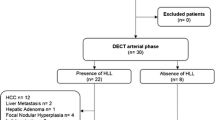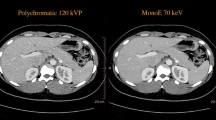Abstract
Purpose
To investigate a benefit from virtual monoenergetic reconstructions (VMIs) for assessment of arterially hyper-enhancing liver lesions in phantom and patients and to compare hybrid-iterative and spectral image reconstructions of conventional images (CI-IR and CI-SR).
Methods
All imaging was performed on a SDCT (Philips Healthcare, Best, The Netherlands). Images of a non-anthropomorphic phantom with a lesion-mimicking insert (containing iodine in water solution) and arterial-phase images from contrast-enhanced patient examinations were evaluated. VMIs (40–200 keV, 10 keV increment), CI-IR, and CI-SR were reconstructed using different strengths of image denoising. ROIs were placed in lesions, liver/matrix, muscle; signal-to-noise, contrast-to-noise, and lesion-to-liver ratios (SNR, CNR, and LLR) were calculated. Qualitatively, 40, 70, and 110 keV and CI images were assessed by two radiologists on five-point Likert scales regarding overall image quality, lesion assessment, and noise.
Results
In phantoms, SNR was increased threefold by VMI40keV compared with CI-IR/SR (5.8 ± 1.1 vs. 18.8 ± 2.2, p ≤ 0.001), while no difference was found between CI-IR and CI-SR (p = 1). Denoising was capable of noise reduction by 40%. In total, 20 patients exhibiting 51 liver lesions were assessed. Attenuation was the highest in VMI40keV, while image noise was comparable to CI-IR resulting in a threefold increase of CNR/LLR (CI-IR 1.3 ± 0.8/4.4 ± 2.0, VMI40keV: 3.8 ± 2.7/14.2 ± 7.5, p ≤ 0.001). Subjective lesion delineation was the best in VMI40keV image (p ≤ 0.01), which also provided the lowest perceptible noise and the best overall image quality.
Conclusions
VMIs improve assessment of arterially hyper-enhancing liver lesions since they increase lesion contrast while maintaining low image noise throughout the entire keV spectrum. These data suggest that to consider VMI screening after arterially hyper-enhancing liver lesions.




Similar content being viewed by others
Abbreviations
- VMI:
-
Virtual monoenergetic image
- DECT:
-
Dual-energy computed tomography
- DSCT:
-
Dual-source computed tomography
- SDCT:
-
Spectral detector computed tomography
- CI-IR:
-
Conventional images reconstructed with an hybrid-iterative reconstruction algorithm
- CI-SR:
-
Conventional images reconstructed with the spectral reconstruction algorithm
- LLR:
-
Lesion-to-liver ratio
References
Kanematsu M, Kondo H, Goshima S, et al. (2006) Imaging liver metastases: review and update. Eur J Radiol 58:217–228. https://doi.org/10.1016/j.ejrad.2005.11.041
Bressler EL, Alpern MB, Glazer GM, Francis IR, Ensminger WD (1987) Hypervascular hepatic metastases: CT evaluation. Radiology 162:49–51. https://doi.org/10.1148/radiology.162.1.3024210
Burkholz KJ, Silva AC (2008) AJR teaching file: hypervascular metastasis or hepatic hemangioma? Am J Roentgenol 190:53–56. https://doi.org/10.2214/AJR.07.7074
Klotz T, Montoriol PF, Da Ines D, et al. (2013) Hepatic haemangioma: common and uncommon imaging features. Diagn Interv Imaging 94:849–859. https://doi.org/10.1016/j.diii.2013.04.008
Burgener FA, Hamlin DJ (1983) Contrast enhancement of focal hepatic lesions in CT: effect of size and histology. Am J Roentgenol 140:297–301. https://doi.org/10.2214/ajr.140.2.297
McCollough CH, Leng S, Yu L, Fletcher JG (2015) Dual- and multi-energy CT: principles, technical approaches, and clinical applications. Radiology 276:637–653. https://doi.org/10.1148/radiol.2015142631
Bushberg JT (1998) The AAPM/RSNA physics tutorial for residents. X-ray interactions. Radiographics 18:457–468. https://doi.org/10.1148/radiographics.18.2.9536489
Flohr TG, McCollough CH, Bruder H, et al. (2006) First performance evaluation of a dual-source CT (DSCT) system. Eur Radiol 16:256–268. https://doi.org/10.1007/s00330-005-2919-2
Riederer SJ, Mistretta CA (1977) Selective iodine imaging using K-edge energies in computerized X-ray tomography. Med Phys 4:474–481. https://doi.org/10.1118/1.594357
Manjunatha HC, Rudraswamy B (2013) Study of effective atomic number and electron density for tissues from human organs in the energy range of 1 keV-100 GeV. Health Phys 104:158–162. https://doi.org/10.1097/HP.0b013e31827132e3
Shuman WP, Green DE, Busey JM, et al. (2014) Dual-energy liver CT: effect of monochromatic imaging on lesion detection, conspicuity, and contrast-to-noise ratio of hypervascular lesions on late arterial phase. Am J Roentgenol 203:601–606. https://doi.org/10.2214/AJR.13.11337
Yeh BM, Shepherd JA, Wang ZJ, et al. (2009) Dual-energy and low-kVp CT in the abdomen. AJR Am J Roentgenol 193:47–54. https://doi.org/10.2214/AJR.09.2592
Thieme SF, Johnson TRC, Lee C, et al. (2009) Dual-energy CT for the assessment of contrast material distribution in the pulmonary parenchyma. Am J Roentgenol 193:144–149. https://doi.org/10.2214/AJR.08.1653
De Cecco CN, Laghi A, Schoepf UJ, Meinel FG (2015) Dual Energy CT. Oncology. https://doi.org/10.1007/978-3-319-19563-6
Carrascosa PM, Cury RC, García MJ, Leipsic JA (2015) Dual-Energy CT. Cardiovasc Imaging. https://doi.org/10.1007/978-3-319-21227-2
Dobeli KL, Lewis SJ, Meikle SR, Thiele DL, Brennan PC (2013) Noise-reducing algorithms do not necessarily provide superior dose optimisation for hepatic lesion detection with multidetector CT. Br J Radiol . https://doi.org/10.1259/bjr.20120500
Aurumskjold ML, Ydstro K, Tingberg A, Söderberg M (2016) Improvements to image quality using hybrid and model-based iterative reconstructions: a phantom study. Acta Radiol . https://doi.org/10.1177/0284185116631180
Kligerman S, Mehta D, Farnadesh M, et al. (2013) Use of a hybrid iterative reconstruction technique to reduce image noise and improve image quality in obese patients undergoing computed tomographic pulmonary angiography. J Thorac Imaging 28:49–59. https://doi.org/10.1097/RTI.0b013e31825412b2
Shuman WP, Chan KT, Busey JM, et al. (2014) Standard and reduced radiation dose liver CT images: adaptive statistical iterative reconstruction vs. model-based iterative reconstruction—comparison of findings and image quality. Radiology 273:793–800. https://doi.org/10.1148/radiol.14140676
Vonder M, Pelgrim GJ, Meyer M, et al. (2017) Dose reduction techniques in coronary calcium scoring: the effect of iterative reconstruction combined with low tube voltage on calcium scores in a thoracic phantom. Eur J Radiol 93:229–235. https://doi.org/10.1016/j.ejrad.2017.06.001
Schneider D, Apfaltrer P, Sudarski S, et al. (2014) Optimization of kiloelectron volt settings in cerebral and cervical dual-energy CT angiography determined with virtual monoenergetic imaging. Acad Radiol 21:431–436. https://doi.org/10.1016/j.acra.2013.12.006
Albrecht MH, Scholtz J-E, Hüsers K, et al. (2016) Advanced image-based virtual monoenergetic dual-energy CT angiography of the abdomen: optimization of kiloelectron volt settings to improve image contrast. Eur Radiol 26:1863–1870. https://doi.org/10.1007/s00330-015-3970-2
Apfaltrer P, Sudarski S, Schneider D, et al. (2014) Value of monoenergetic low-kV dual energy CT datasets for improved image quality of CT pulmonary angiography. Eur J Radiol 83:322–328. https://doi.org/10.1016/j.ejrad.2013.11.005
Sudarski S, Apfaltrer P, Nance JW, et al. (2014) Objective and subjective image quality of liver parenchyma and hepatic metastases with virtual monoenergetic dual-source dual-energy CT reconstructions. An analysis in patients with gastrointestinal stromal tumor. Acad Radiol 21:514–522. https://doi.org/10.1016/j.acra.2014.01.001
Aurumskjöld M-L, Ydström K, Tingberg A, Söderberg M (2017) Improvements to image quality using hybrid and model-based iterative reconstructions: a phantom study. Acta Radiol 58:53–61. https://doi.org/10.1177/0284185116631180
Khawaja RDA, Singh S, Otrakji A, et al. (2015) Dose reduction in pediatric abdominal CT: use of iterative reconstruction techniques across different CT platforms. Pediatr Radiol 45:1046–1055. https://doi.org/10.1007/s00247-014-3235-2
Altenbernd J, Heusner TA, Ringelstein A, et al. (2011) Dual-energy-CT of hypervascular liver lesions in patients with HCC: investigation of image quality and sensitivity. Eur Radiol 21:738–743. https://doi.org/10.1007/s00330-010-1964-7
Grant KL, Flohr TG, Krauss B, et al. (2014) Assessment of an Advanced image-based technique to calculate virtual monoenergetic computed tomographic images from a dual-energy examination to improve contrast-to-noise ratio in examinations using iodinated contrast media. Invest Radiol 49:586–592. https://doi.org/10.1097/RLI.0000000000000060
Leng S, Yu L, Fletcher JG, McCollough CH (2015) Maximizing iodine contrast-to-noise ratios in abdominal CT imaging through use of energy domain noise reduction and virtual monoenergetic dual-energy CT. Radiology 276:562–570. https://doi.org/10.1148/radiol.2015140857
Kalender WA, Klotz E, Kostaridou L (1988) An algorithm for noise suppression in dual energy CT material density images. IEEE Trans Med Imaging 7:218–224. https://doi.org/10.1109/42.7785
Kelcz F, Joseph PM, Hilal SK (1979) Noise considerations in dual energy CT scanning. Med Phys 6:418–425. https://doi.org/10.1118/1.594520
Chang W, Lee JM, Lee K, et al. (2013) Assessment of a model-based, iterative reconstruction algorithm (MBIR) regarding image quality and dose reduction in liver computed tomography. Invest Radiol 48:598–606. https://doi.org/10.1097/RLI.0b013e3182899104
Husarik DB, Gordic S, Desbiolles L, et al. (2015) Advanced virtual monoenergetic computed tomography of hyperattenuating and hypoattenuating liver lesions. Invest Radiol 50:695–702. https://doi.org/10.1097/RLI.0000000000000171
Willemink MJ, Leiner T, De Jong PA, et al. (2013) Iterative reconstruction techniques for computed tomography part 2: initial results in dose reduction and image quality. Eur Radiol 23:1632–1642. https://doi.org/10.1007/s00330-012-2764-z
Ruoqiao Zhang R, Thibault J-B, Bouman CA, Sauer KD, Jiang Hsieh J (2014) Model-based iterative reconstruction for dual-energy X-ray CT using a joint quadratic likelihood model. IEEE Trans Med Imaging 33:117–134. https://doi.org/10.1109/TMI.2013.2282370
Author information
Authors and Affiliations
Corresponding author
Ethics declarations
Funding
No funding were received for this study.
Conflict of interest
GP is an employee of Philips Healthcare. DM received reimbursements for talks outside this specific project from Philips Healthcare. NGH, AJH, JD, DWJ, TP, and SH all declare that they have no conflict of interest.
Ethical approval
All procedures performed in studies involving human participants were in accordance with the ethical standards of the institutional and/or national research committee and with the 1964 Helsinki declaration and its later amendments or comparable ethical standards.
Informed consent
The institutional review board approved this study and waived informed consent due to the retrospective study design.
Human and animal rights
This article does not contain any studies with animals performed by any of the authors.
Electronic supplementary material
Below is the link to the electronic supplementary material.
Rights and permissions
About this article
Cite this article
Große Hokamp, N., Höink, A.J., Doerner, J. et al. Assessment of arterially hyper-enhancing liver lesions using virtual monoenergetic images from spectral detector CT: phantom and patient experience. Abdom Radiol 43, 2066–2074 (2018). https://doi.org/10.1007/s00261-017-1411-1
Published:
Issue Date:
DOI: https://doi.org/10.1007/s00261-017-1411-1




